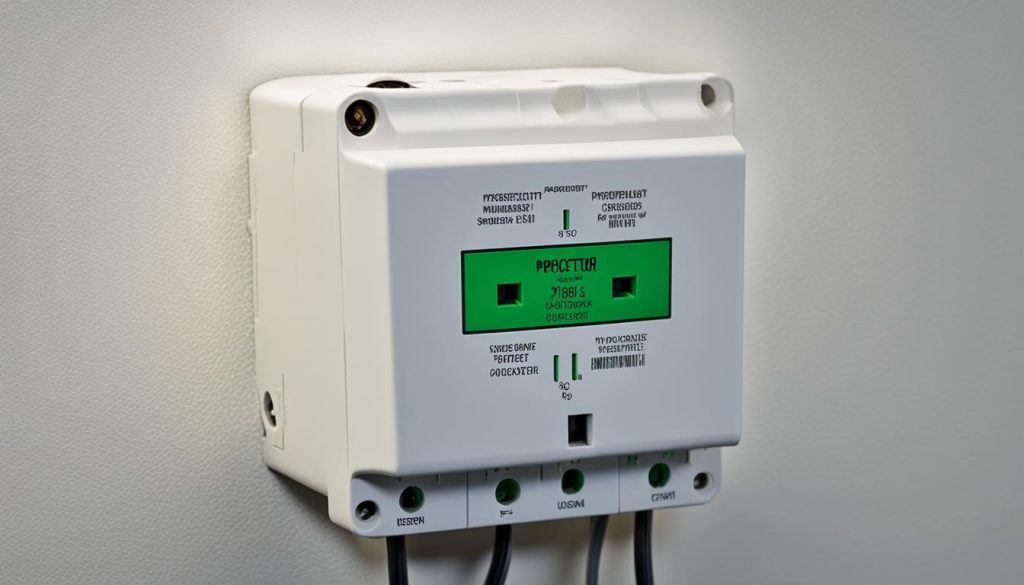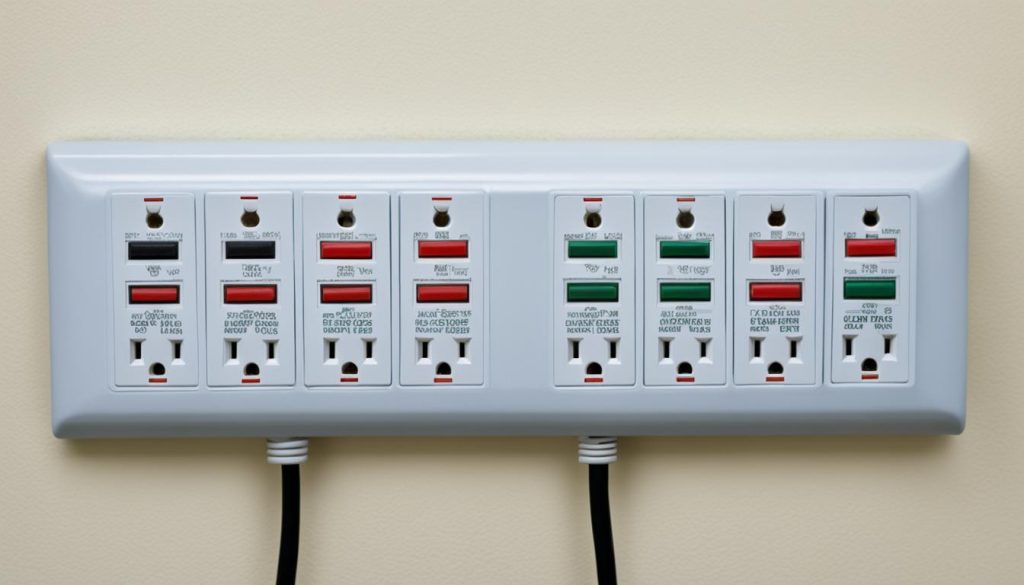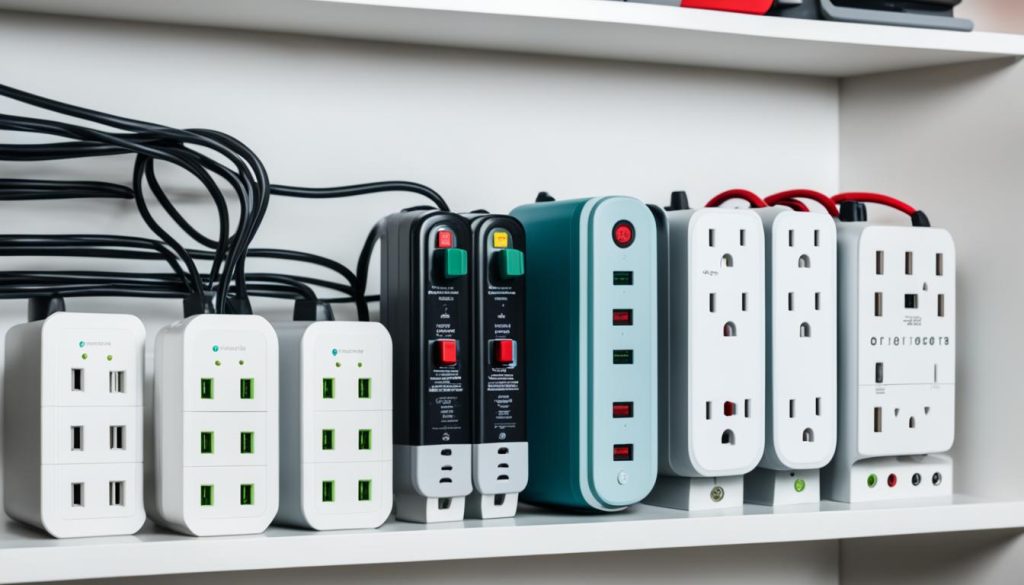Welcome to our informative guide on power strips and surge protectors. If you have ever wondered about the difference between these two essential electrical accessories, you have come to the right place. In this article, we will explore the functions and benefits of power strips and surge protectors, helping you understand which one is best suited for your needs.
Key Takeaways:
- A power strip provides extra outlets, while a surge protector defends against voltage spikes that can damage your electronics.
- Surge protectors have a joules rating to measure the level of protection they provide.
- Power strips without surge protection leave your electronics vulnerable to surges.
- When choosing between a power strip and a surge protector, consider the level of protection needed and the value of your devices.
- Surge protectors are essential for safeguarding sensitive electronics from potential harm.
Understanding Power Strips
Power strips are essential devices for providing additional electrical outlets in both residential and commercial areas. They are designed to meet the increasing power demands of modern electronics and appliances. Whether you need to power multiple devices in your home office or connect various equipment in a workshop, power strips offer the convenience and flexibility you require.
One of the main advantages of power strips is the ability to expand your available outlets. With their multiple sockets, power strips ensure that you have enough connections for all your devices. This eliminates the need for constantly unplugging and re-plugging devices, making your workspace more efficient.
Power strips often come equipped with additional features to enhance functionality. For instance, many power strips include an integrated circuit breaker. The circuit breaker acts as a safety measure, automatically shutting off the power to prevent electrical overload or short circuits. This protects your devices from potential damage and minimizes the risk of electrical fires.
Moreover, power strips typically have an on/off switch, allowing you to easily control the power supply to connected devices. This offers convenience and energy savings. By switching off the power strip when not in use, you can conserve power and reduce electricity consumption.
It’s important to note that not all power strips have built-in surge protection. While power strips provide extra outlets, they do not offer protection against voltage spikes that can damage your devices. Surge protectors, on the other hand, are specifically designed to safeguard your electronics from power surges.
Before using a power strip, it’s crucial to determine whether surge protection is necessary for your devices. If you have valuable electronics or sensitive equipment that require protection against voltage spikes, consider using a surge protector instead of a standard power strip.
Below is a visual representation of the main components and features of a typical power strip:
Figure 1: Components and Features of a Power Strip
Exploring Surge Protectors
When it comes to protecting your electronics from voltage spikes, surge protectors are an essential investment. These devices are specifically designed to safeguard your valuable equipment from sudden surges in electrical current that could cause irreparable damage. Let’s explore the key features and benefits of surge protectors and understand why they are an indispensable tool for protecting your electronics.
The Importance of Joules Rating
One of the most critical factors to consider when choosing a surge protector is its joules rating. The joules rating indicates the energy absorption capacity of the surge protector. In simple terms, the higher the joules rating, the greater the level of protection it provides. Surge protectors with higher joules ratings can better handle powerful surges and ensure enhanced safety for your electronics.
For example, a surge protector with a joules rating of 2000 will be more effective in shielding your electronics compared to one with a rating of 1000.
Protection for Your Electronics
Surge protectors act as a barricade between your electronics and harmful voltage spikes. They divert excessive electricity through grounded connections, effectively preventing it from damaging your equipment. By using a surge protector, you can have peace of mind knowing that your devices are shielded against potential power surges.
Whether it’s your valuable entertainment systems, computers, or sensitive televisions, surge protectors offer reliable protection for a wide range of electronics.
Commercial Surge Protectors
While surge protectors are commonly used in homes, they are also essential in commercial settings where larger appliances and equipment are present. Commercial surge protectors are designed to handle greater electrical loads and provide robust protection for industrial electronics, office equipment, and other power-hungry devices.
Businesses can greatly benefit from using commercial surge protectors to safeguard their valuable assets, prevent downtime, and minimize the risk of costly equipment damage.

Comparing Surge Protectors
Let’s compare different surge protectors based on their key features:
| Surge Protector Model | Joules Rating | Number of Outlets | Price |
|---|---|---|---|
| Model A | 1000 | 6 | $19.99 |
| Model B | 2000 | 8 | $29.99 |
| Model C | 3000 | 10 | $39.99 |
As shown in the table above, surge protectors with higher joules ratings tend to offer more outlets, providing greater flexibility for connecting multiple devices. However, it’s important to consider your specific needs and budget when choosing the right surge protector for your situation.
Now that we’ve explored surge protectors and their benefits, let’s dive deeper into the importance of surge protection in the next section.
The Importance of Surge Protection
An electrical power surge is a sudden increase in the electrical current flowing through your building’s wiring. These surges can occur due to various factors, such as faulty wiring, the switching on or off of high-powered devices, or even lightning strikes. Unfortunately, power surges can have damaging effects on your electronic devices and appliances.
During a power surge, the excess voltage can overwhelm the delicate components of your electronics, leading to malfunctions or complete failures. This can result in costly repairs or replacement of your devices. Furthermore, power surges also pose a significant fire risk. The excessive heat generated during a surge can cause circuits to overheat and potentially ignite, posing a danger to your property and personal safety.
To safeguard your electronics and reduce the risk of fire, it is essential to invest in surge protection. Surge protectors are devices designed to absorb and redirect the extra electrical current during a power surge. By diverting the excessive voltage to the ground, surge protectors prevent it from reaching your devices and causing damage.
Surge protectors provide a vital layer of defense for your sensitive and valuable electronics, such as computers, televisions, gaming consoles, and home theater systems. By using surge protectors, you can enjoy peace of mind knowing that your devices are protected from electrical power surges, minimizing the potential for damage and extending their lifespan.
“Investing in surge protection is like purchasing an insurance policy for your electronics. It’s a small cost upfront that can save you from significant expenses and headaches in the long run.” – Electrical Safety Expert
Take a look at the table below to understand the potential risks and benefits of surge protection:
table {
width: 100%;
border-collapse: collapse;
}
th, td {
border: 1px solid #ddd;
padding: 8px;
}
th {
text-align: left;
background-color: #f2f2f2;
}
| Surge Protection | Benefits | Risks |
|---|---|---|
| Protection against electrical power surges | Prevents damage to electronics and appliances | Cost of purchasing surge protectors |
| Fire risk mitigation | Reduces the likelihood of fires caused by power surges | Occasional replacement of surge protectors |
| Prolongs the lifespan of electronic devices | Minimizes the need for costly repairs or replacements | Installation and maintenance efforts |
As illustrated in the table, surge protection offers significant benefits in terms of preventing damage to electronics, reducing fire risk, and extending the lifespan of your devices. While there may be some costs associated with purchasing surge protectors and occasional replacements, these expenses are minimal compared to the potential losses and hazards that power surges can cause.
Investing in surge protection is a proactive measure that ensures the longevity and safe operation of your electronics while providing valuable protection against electrical power surges and associated risks.

Choosing the Right Surge Protector
When it comes to selecting a surge protector, there are several factors to consider. These include the wattage it can handle, the cost, durability, and replaceability.
The wattage of the surge protector should match the power requirements of the devices you plan to connect to it. It’s important to choose a surge protector with a wattage rating that can handle the electrical load of your equipment to ensure optimal performance and protection.
Cost is another important consideration. While there are budget-friendly surge protectors available, it’s worth investing in a quality one that provides adequate protection for your valuable electronics. Remember, the cost of replacing damaged devices far outweighs the initial investment in a reliable surge protector.
Durability is crucial for a surge protector to withstand regular use and potential surges. Look for surge protectors made with high-quality materials and robust construction to ensure long-lasting protection.
Replaceability is also an important aspect to consider. Surge protectors wear out over time and may need to be replaced. Opt for surge protectors that offer replaceable components or come with a warranty, providing peace of mind and cost savings in the long run.
In summary, when choosing a surge protector, pay attention to the wattage, cost, durability, and replaceability. By selecting a surge protector that meets these criteria, you can ensure the safety and protection of your valuable electronic devices.

| Feature | Selection Criteria |
|---|---|
| Wattage | Choose a surge protector that can handle the power requirements of your devices. |
| Cost | Invest in a quality surge protector that provides adequate protection for your valuable electronics. |
| Durability | Look for surge protectors made with high-quality materials and robust construction. |
| Replaceability | Opt for surge protectors with replaceable components or warranties for long-term use. |
Power Strip vs Surge Protector: Which One to Choose?
When it comes to protecting your valuable electronics, the choice between a power strip and a surge protector is an important consideration. Both options serve different purposes, so it’s essential to understand their differences and choose the right one based on your needs and the level of protection you require.
Power strips are affordable and convenient solutions for providing additional electrical outlets. They are designed to expand your existing outlet capacity, making them suitable for simple electrical needs. Power strips typically come with multiple outlets, allowing you to connect several devices at once. However, it’s crucial to note that not all power strips have built-in surge protection.
Surge protectors, on the other hand, offer an added layer of defense against unexpected voltage spikes that can damage your electronics. They are specifically designed to redirect excessive electrical current to the ground, ensuring your devices remain protected. Surge protectors are equipped with a joules rating, which measures the amount of energy they can absorb. Higher joules ratings indicate better protection for your electronics.
Protection for Electronics
If you want to safeguard your sensitive electronics from power surges, a surge protector is essential. Televisions, computers, home entertainment systems, and other valuable devices can be vulnerable to damage caused by voltage spikes. By using a surge protector, you can provide your electronics with the defense they need to prevent potential harm.
Cost Comparison
When it comes to cost, power strips are more affordable compared to surge protectors. Power strips are readily available and come in a range of prices, making them a cost-effective option for expanding your outlet capacity. On the other hand, surge protectors may be slightly more expensive due to the additional surge protection features they offer. However, investing in a quality surge protector is worth the cost to protect your valuable electronics from potential damage.
Consider the value of the devices you want to protect and the cost of potential damage that can occur during a power surge. Remember, the cost of replacing or repairing damaged electronics can be significantly higher than investing in a surge protector upfront.
Ultimately, the decision between a power strip and a surge protector depends on your specific needs and the level of protection you require. If you only need extra outlets for basic electrical needs, a power strip will suffice. However, if you want to ensure the safety of your valuable electronics and protect them from potential power surges, a surge protector is the ideal choice.
Remember to assess the cost and value of your devices before making a decision. Prioritizing the protection of your electronics can save you from costly repairs or replacements in the long run.

Power Strip vs Surge Protector Comparison
| Feature | Power Strip | Surge Protector |
|---|---|---|
| Primary Purpose | Expand outlet capacity | Protect against power surges |
| Extra Features | Circuit breaker, on/off switch | Joules rating, indicator lights |
| Device Protection | No surge protection | Provides surge protection |
| Cost | Affordable | Varies, higher compared to power strips |
| Recommended for | Simple electrical needs | Sensitive electronics, valuable devices |
Conclusion
Understanding the difference between a power strip and a surge protector is crucial for protecting your electronics. While power strips provide extra outlets, surge protectors offer the added protection against voltage spikes that can damage your devices.
Investing in a surge protector is a wise decision to safeguard your valuable electronics from potential harm. Power surges, whether caused by faulty wiring, high-powered device usage, or lightning strikes, can lead to overheating, burnt circuits, and even fires. With a surge protector, the extra current is redirected to the ground, effectively protecting your devices from damage.
Whether in a residential or commercial setting, it’s essential to prioritize surge protection to avoid the risk of costly repairs or replacement of your electronic devices. By choosing the right surge protector based on wattage capacity, durability, and cost, you can provide optimal protection for your electronics against power surges.
Don’t compromise the safety of your electronics. Invest in a quality surge protector and ensure that your devices remain safeguarded from potential electrical hazards. The importance of surge protection cannot be overstated when it comes to protecting your valuable electronics.
FAQ
What is the difference between a power strip and a surge protector?
The difference between a power strip and a surge protector is that a power strip adds extra outlet space while a surge protector defends against possible voltage spikes that could damage your electronics, appliances, or equipment.
What is a power strip?
A power strip is a device that provides additional electrical outlets. It usually has several outlets, a circuit breaker, and an on/off switch, making it convenient for using multiple electronics in close proximity.
What is a surge protector?
A surge protector is designed to protect your electronics from voltage spikes. It has a joules rating that indicates the level of protection it provides.
How does a surge protector work?
Surge protectors redirect extra current to the ground, protecting your devices from voltage spikes that can cause damage. They act as a barrier between your electronics and the electrical current in your building.
What is a joules rating?
A joules rating measures how long your appliances will be protected by a surge protector. Higher joules ratings offer better protection against voltage spikes.
What appliances are suitable for using with surge protectors?
Surge protectors are ideal for use with sensitive electronics like televisions, computers, and home entertainment systems. Commercial surge protectors are available for larger appliances and equipment.
What is an electrical power surge?
An electrical power surge is a spike in your building’s electrical current that can cause damage to your electronics and appliances. Power surges can occur due to faulty wiring, turning on or off high-powered devices, or lightning strikes.
Why is surge protection important?
Surge protection is important because power surges can lead to overheating, burnt circuits, and even fires. Surge protectors help redirect the extra current to the ground, protecting your devices from potential harm.
How do I choose the right surge protector?
When selecting a surge protector, consider the wattage it can handle, the cost, its durability, and how often it needs to be replaced. The wattage should be appropriate for the devices you will be using with it. It’s worth investing in a quality surge protector to protect your valuable electronics.
Which one should I choose, a power strip or a surge protector?
The choice between a power strip and a surge protector depends on your needs and the level of protection you require. Power strips are more affordable and provide extra outlets, making them suitable for simple electrical needs. However, if you want to protect sensitive electronics from power surges, a surge protector is essential.
What is the cost comparison between a power strip and a surge protector?
Power strips are generally more affordable than surge protectors. However, considering the cost of your valuable electronics and the potential damage that power surges can cause, investing in a surge protector is a wise decision for long-term protection.


